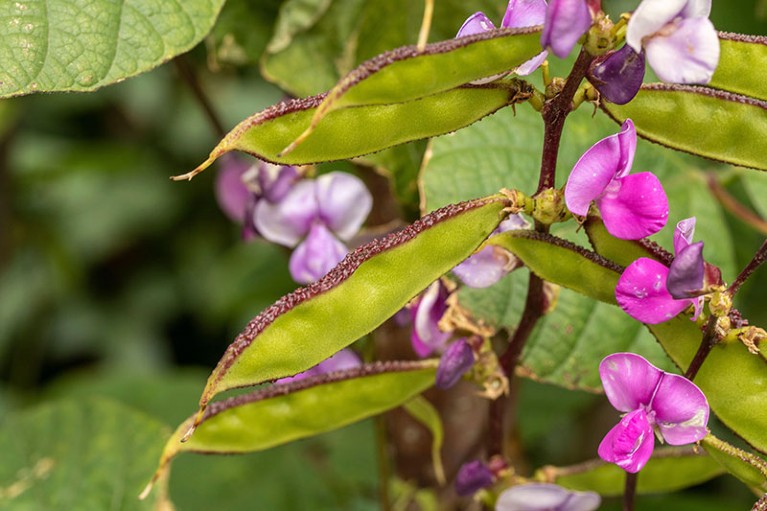Lablab (Lablab purpureus) is an important crop for food security and sustainable agriculture throughout the tropics, where it is known by more than 150 local names1, among them dolichos bean and hyacinth bean. This legume has outstanding drought tolerance, is nutritious and has medicinal properties2. It can be used in many ways: eaten as a vegetable or as a dry, dehulled split bean (or dhal); as feed for animals; or as green manure3. But a lack of advanced breeding resources has made improvements in these characteristics extremely slow, leaving lablab’s potential largely untapped. Writing in Nature Communications, Njaci et al.4 report that they have sequenced lablab’s genome. The results provide insight into its domestication and genetic diversity, and could be useful in future breeding efforts.
The need to sequence the genome of lablab (Fig. 1) was highlighted about a decade ago by the African Orphan Crops Consortium (AOCC). It was on a list generated by the consortium of 101 under-researched but highly nutritious African crops that it would target for sequencing and resequencing (see go.nature.com/3rbtr2g).
Figure 1 | A lablab plant. Njaci et al.4 have sequenced a reference genome for Lablab purpureus.Credit: Garey Lennox/Alamy
As part of a separate effort, Njaci et al. generated a whole-genome sequence for lablab at the Biosciences eastern and central Africa–International Livestock Research Institute (BecA–ILRI) hub in Nairobi, Kenya. The scientists used the MinION sequencer — one of the smallest and most portable sequencing platforms available — to produce the sequence. In total, they generated 4.7 million stretches of sequence, which were, on average, 6.1 kilobases long. Together, the sequences were long enough to cover the lablab genome, on average, more than 60 times.
The accuracy of MinION is lower than that of other sequencing platforms5, so Njaci and co-workers made use of publicly available data from a less error-prone platform to identify and correct any mistakes in their data sets. This resulted in the assembly of a high-quality genome.
The researchers used this reference genome to address some key questions related to the domestication and genetic diversity of lablab. Fortunately, the BecA-ILRI hub provided them with access to high-computing infrastructure and bioinformatics expertise, which would have otherwise been a major barrier to these analyses.
Njaci and colleagues first asked whether the two main subsets of lablab (one producing four seeds per pod and the other two) had been domesticated independently. They used their reference genome to assemble sequencing data from 23 individual plants (accessions), including both wild and domesticated two- and four-seeded lablabs. Comparison of the DNA differences revealed by the sequences led the authors to the preliminary conclusion that lablab must have been domesticated at least twice — once for each subset.
The group recommends that these subsets could be reclassified into distinct taxa, but more work will be needed to investigate the domestication events conclusively. Lablab is considered a highly morphologically diverse legume crop6, and an exhaustive genetic study would include hundreds, if not thousands, of accessions from across all regions where the crop is grown, as has been achieved for chickpea (Cicer arietinum)7. Given the small size of the lablab genome (about 423 megabases), such a project should be relatively inexpensive.
Next, Njaci et al. analysed genetic data from a diverse collection of 203 lablab accessions from across 25 countries, all of which were already available at the BecA-ILRI hub. They generated DNA markers that varied between the plants to determine how truly diverse and representative of the range of lablabs the collection was. The authors established that 191 out of the 203 accessions were genetically distinct from one another. They confirmed that the accessions could be divided into two genetically different groups (gene pools) on the basis of the numbers of seeds per pod, and found low genetic diversity in each gene pool. This is not surprising, considering the predominantly self-pollinating nature of the crop.
The researchers went on to establish possible associations between their DNA markers and agronomic data for 125 accessions. Despite the low number of accessions, the researchers’ results indicate that some markers are associated with desirable agronomic traits, such as plant height. However, the markers identified will need to be validated further using larger population sizes before deployment in routine breeding.
Beyond the scientific insights gained, Njaci and colleagues’ achievement is valuable because there have been few reports of African crops for which data were generated and analysed in Africa. The work highlights the possibility that a small, portable sequencing device could enable scientists from the remotest parts of the world to gain access to genomics data. As such, the study opens a new chapter for scientists based in Africa, especially those who already have all the skills needed to design, analyse and report similar results.
The publication of African research in renowned journals will help to motivate Africa’s scientists. Much effort will still be needed to build infrastructure capacity and to increase staffing levels. Furthermore, major crop-genomics organizations that are working in the continent — such as the International Crops Research Institute for the Semi-Arid Tropics, BecA–ILRI and the AOCC — must take on the responsibility of mentoring scientists in national programmes to ensure that Africa’s researchers receive the support they need to maintain the momentum of their work.
Copyright © 2024 International Society of Bionic Engineering All Rights Reserved
吉ICP备11002416号-1









